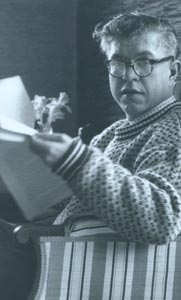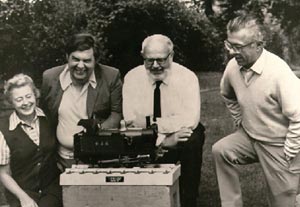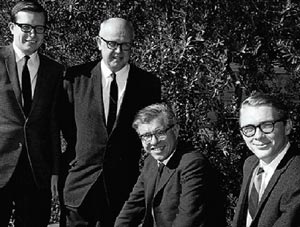Fred Hoyle, who died in 2001, is best known as a cosmologist. But, as Simon Mitton relates, his career in physics began with the weak interaction and moved on to a crucial discovery in nuclear physics.
Fred Hoyle, the great cosmologist, nuclear astrophysicist and controversialist, was born 90 years ago in the beautiful county of Yorkshire in the north of England. Hoyle’s first science teacher was his father, who supplied the boy with books and apparatus for chemistry experiments. By the age of 15 he was making highly toxic phosphine (PH3) in his mother’s kitchen, and terrifying his young sister with explosions. In high school he excelled in mathematics, chemistry and physics, and in 1933 won a place at Cambridge to study physics.

On arrival at Cambridge he immediately demonstrated his fierce independence by telling his astonished tutor that he was switching from physics to applied mathematics. The future nuclear astrophysicist foresaw that Cambridge mathematics rather than laboratory physics would give him the right start as a theorist. The country boy displayed an astonishing talent at mathematics, even by the highest standards of the university. He skipped the second year completely, yet graduated with the highest marks in his year. That soaring achievement won him a position as a research student in the Cavendish Laboratory, where Ernest Rutherford held the chair of experimental physics. By the 1930s Rutherford had created for Cambridge the greatest nuclear physics laboratory in the world.
Hoyle identified Rudolph Peierls as a supervisor. Peierls, a German citizen and son of a Jewish banker, had studied quantum theory under the pioneer Werner Heisenberg. In 1933 Peierls and his young wife had escaped the anti-Jewish practices of the Nazi regime; they arrived in Cambridge via Stalin’s Russia. Peierls won a one-year fellowship from the Rockefeller Foundation, and by the time Hoyle tracked him down he had just returned from spending six months in Rome with Enrico Fermi. Peierls immediately set Hoyle the task of improving Fermi’s theory of beta decay, published in 1934. This led, in 1937, to Hoyle’s first research paper, “The generalised Fermi interaction”.
In 1938 Paul Dirac, who had won the Nobel prize in 1933, became Hoyle’s supervisor because Peierls had left Cambridge for a permanent position in nuclear physics at the University of Birmingham. Just one year under Dirac’s silent tutelage enabled Hoyle to produce two papers in quantum electrodynamics, both of them masterpieces.
The impending 1939-1945 war curtailed Hoyle’s career as a theoretical nuclear physicist. In January 1939 he read of Irène and Frédérick Joliot-Curies’ discovery that the fission of uranium by neutron bombardment produced a fresh flood of neutrons. The nuclear physicists in the Cavendish Laboratory immediately realized that a chain reaction could be used to create a nuclear bomb. Hoyle foresaw that war research would drain the UK universities of scientists and mathematicians. Wishing to avoid being drafted for weapons research, he changed his research interest to theoretical astronomy and offered his services to the nation as a weather forecaster. The British authorities declined this suggestion. Instead he found himself engaged in radar countermeasures for the war at sea, a field in which he worked with great distinction that was never publicly recognized.

In late 1944 the US Navy convened a secret meeting in Washington for the US and UK to share knowledge of radar research. Hoyle was one of two UK delegates. Outside of the meeting he used his time productively. He flew out to the US west coast to meet Walter Baade, one of the greatest observational astrophysicists of the 20th century. Baade introduced Hoyle to papers that he had missed during his war work, about the extremely high temperatures in supernovae. Baade taught him that a supernova is a nuclear explosion triggered by stellar collapse: “Maybe a star is like a nuclear weapon!” was how Baade put it.
Hoyle returned to England via Montreal, his itinerary allowing him to visit the Chalk River Laboratories. This Canadian facility had played host to British research on nuclear weapons since 1942. From a former Cavendish Laboratory contact, Hoyle learned some of Britain’s nuclear secrets first-hand. What particularly amazed him was how far the measurements of energy levels in nuclei had progressed. Hoyle now made an important connection: what would the nuclear chain reactions look like in an exploding star?
The post-war period
At the conclusion of the war in Europe, Hoyle walked out of his job as a radar scientist (he could have continued if he had wished), and returned to Cambridge as a lecturer. He immediately turned his mind to nuclear reactions in massive stars with central temperatures of around 3 x 109 K. Astrophysicists had long known of the two stellar reactions that synthesize helium from hydrogen. Hoyle, following suggestions by his hero, Arthur Eddington, now asked himself if helium could be processed to the heavier elements via chain reactions. He studied tables giving the natural abundances of the chemical elements, picking up an important clue from the marked increase in abundances around iron, the so-called iron peak. From his solid grasp of nuclear physics and statistical mechanics he convinced himself that the iron nuclei were synthesized in stars at very high temperatures. He set himself the task of working out how stars do it.

He quickly became frustrated at the lack of data on nuclear masses and energy levels. Then, one afternoon in the spring of 1946, he bumped into Otto Frisch. Frisch had recently returned to the UK from Los Alamos, where he had worked on nuclear fission aspects of the Manhattan Project. Frisch directed Hoyle to a declassified compilation on nuclear masses that the British authorities had found in occupied Berlin. Drawing on these data from the wartime atomic-weapons programmes, he now worked alone in St John’s College (rather than the Cavendish Laboratory), searching for the answers to the origin of the elements from beryllium to iron.
A single page in a notebook he had first started in 1945 captures the moment when Hoyle cracked this problem. The notebook has a series of reactions, commencing with 12C capturing 4He, and concluding with Fe. Hoyle treated the problem as one of statistical equilibrium. For example, he wrote down a chain reaction connecting 16O and 20Ne in the following manner: 16O + 4He→←19F + 1H, 19F + 1H→←20Ne + hν. The double arrow symbol he used →← is to indicate that these reactions are occurring in equilibrium, with the action being read from right to left as well as left to right.
Using statistical mechanics, Hoyle calculated the proportions of each isotope that would arise under equilibrium conditions. This is not explosive nucleosynthesis, but a more mundane steady-state alchemy in the cores of red giant stars. Hoyle assumed, correctly as it turned out, that rotational instability and stellar explosions would release the heavier elements inside the star back to the interstellar medium. His scheme neatly matched reality, as its predicted distribution of the different elements corresponded well with their abundance in the natural environment. But there was barely a ripple of interest from the scientific community when Hoyle published his findings in 1946. At that stage he was far ahead of his time in applying nuclear physics to stellar interiors. In the 10 years following publication the paper received just three citations.
One spring afternoon in 1953 a young postdoc, Geoffrey Burbidge, gave a seminar in Cambridge that changed nuclear astrophysics forever. He described the proportions of chemical elements in a peculiar star (γ Gem) that his wife Margaret had just observed. The composition of this star seemed bizarrely different from that of the Sun. The rare earths, from 57La to 71Lu, were spectacularly over-represented: in γ Gem 57La has an abundance 830 times greater than in the Sun. The Burbidges appeared to have discovered a star with nuclear reactions taking place on the surface.
The results greatly excited Willy Fowler of Caltech who was in Cambridge as a Fulbright professor. He already knew of Hoyle’s work on synthesis through the iron peak. Now he introduced himself to the Burbidges saying that his particle accelerator in the Kellogg Radiation Lab could accelerate protons to the energies found in solar flares. He exclaimed: “Geoff, the four of us should attack the problems of nucleosynthesis together.”
Soon after the seminar Fowler and Hoyle joined up again at Caltech. Hoyle had a problem on his mind. His synthesis through to the iron peak started with 12C. Where had the 12C come from? Not from the Big Bang – that made only hydrogen and helium. The synthesis of elements with atomic masses 5 and 8 in stellar interiors was already known to be impossible because there are no stable isotopes with those masses. In the absence of these light isotopes to form a stepping-stone, how could three 4He become 12C? Calculations suggested that anything synthesized from three alpha particles (4He) would be absurdly short-lived. And there the matter rested until Hoyle goaded a reluctant Fowler into action.
One of Fowler’s associates, Edwin Salpeter, had found an enhanced energy level in 8Be that lasted just long enough to react with an alpha particle and make the prized 12C. However, when Hoyle looked at the nuclear physics more closely, he realized that the 12C resulting from Salpeter’s scheme would immediately react to 16O. However, in a flash of inspiration Hoyle tried to make Salpeter’s triple-alpha process work with an enhanced level in 12C. To his amazement he found that if the newly made 12C had a resonance at 7.65 MeV the reaction would proceed at just the correct rate.
Hoyle crashed into Fowler’s office without so much as a “by your leave” and urged him to measure the resonance levels in carbon. The experimentalist wasn’t going to embark on a quest that would take many weeks just because an exotic theorist from England asked him to. But Hoyle persisted and Fowler eventually relented. Hoyle had already returned to his teaching in Cambridge by the time Fowler’s group completed the experiment. They did find the resonance at 7.65 MeV, a discovery that Fowler found absolutely amazing. “From that moment we took Hoyle very seriously indeed,” he later said, because Hoyle had predicted a nuclear-energy level entirely on the basis of an anthropic argument.
The Burbidges, Fowler and Hoyle – “B2FH” – now embarked on an enormous research programme to account for the origin of the elements in the entire Periodic Table. The Burbidges brought the observations to the collaboration, Fowler the nuclear data, and Hoyle and Geoff Burbidge many of the calculations (on hand-cranked machines). Their encyclopaedic paper, always referred to as B2FH, ran to 108 pages, appearing in Reviews of Modern Physics in 1957 (B2FH 1957). It has received 1400 citations, which is very high for a paper in astrophysics. It remains a key paper, which set out the physics of several different mechanisms of nucleosynthesis, including the explosive pathways in which supernovae build the elements beyond the iron peak. The paper led to a lifelong friendship between Fowler and Hoyle, both of whom made many further contributions to nucleosynthesis. Fowler was deeply disturbed and disappointed when Hoyle did not get a share of the 1983 Nobel prize, which went to Chandrasekhar and Fowler.
Fowler strongly supported Hoyle’s plans for an Institute of Theoretical Astronomy in Cambridge. This opened in 1968, with nuclear astrophysics at the heart of the programme. Hoyle used the institute as a platform to re-establish British expertise in all branches of theoretical astronomy. By example he pulled the subject out of the doldrums, inspiring a string of distinguished visitors and a legion of graduate students. His research papers (there are more than 500) show he was wrong more often than he was right. That did not trouble him at all. Among the papers in the “right” class, those on nuclear astrophysics still stand as a towering achievement of central importance to astrophysics.
Further reading
B2FH: E M Burbidge, G R Burbidge, W A Fowler and F Hoyle 1957 Rev. Mod. Phys. 29 547.
Jane Gregory 2005 Fred Hoyle’s Universe Oxford University Press.
D Gough 2005 The Scientific Legacy of Fred Hoyle Cambridge University Press.
www.hoyle.org.uk.





